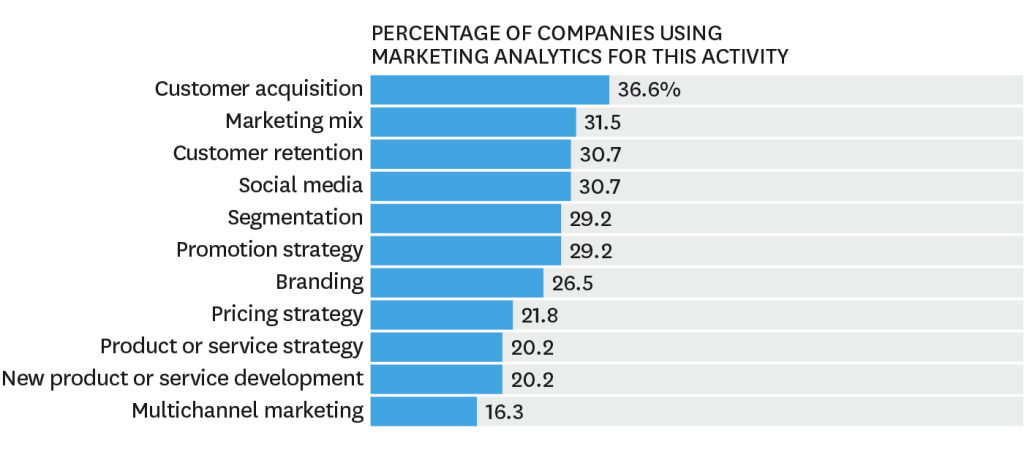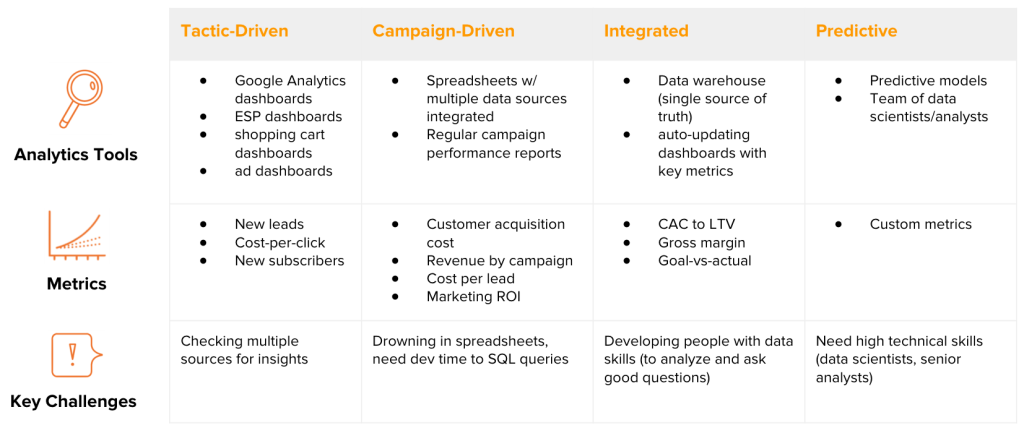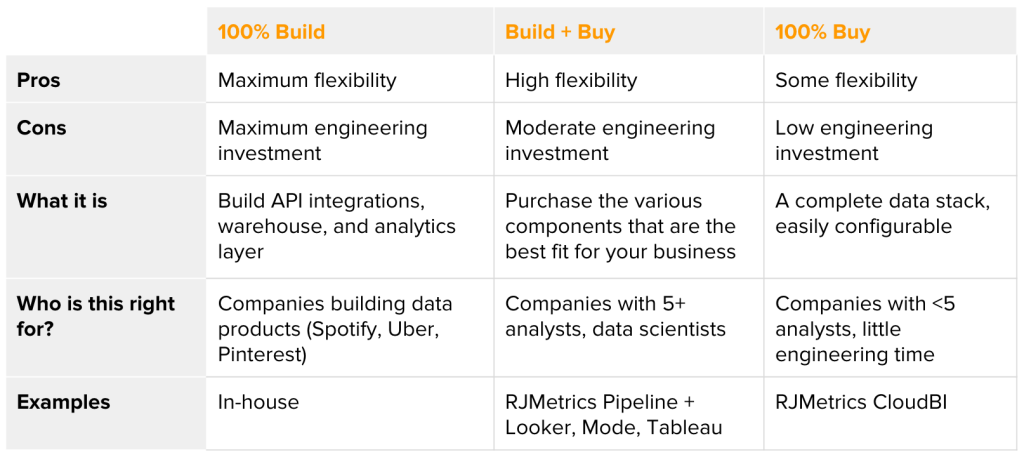It’s hard to overstate the importance of analytics for a marketing team. however, there’s an enormous difference between basic reporting, and much more sophisticated approaches like predictive analytics. Most teams are doing something in between.
In this post, we’re going to walk through the four stages of marketing analytics maturity, and help you identify where your team currently sits. Then we’ll look at what it takes to advance your organization to the next level.
The state of marketing analytics
Before we jump in, let’s pause for a minute and define “marketing analytics.” Wordstream defines marketing analytics as “the practice of measuring, managing, and analyzing marketing performance to maximize its effectiveness and optimize ROI.” Sounds nice in theory, but it’s actually pretty tough to put into practice.
Not surprisingly, most marketing teams struggle on this front. This breakdown by CMO shows the types of activities where marketing teams are most commonly applying analytics. Even the most popular activity, customer acquisition, is only being tracked by 36% of companies.

Why are these numbers so low? Realistically, it’s difficult to do marketing analytics well. A marketing team may have aspirations of tracking certain metrics, but there’s a meaningful amount of data engineering and analytical skill needed to make it a reality.
Marketers today use a vast number of tech tools – email service providers, marketing automation platforms, ad platforms, web analytics, etc. With all these applications, it’s nearly impossible to gain a complete view of what’s going on with your customers or business. Your Mailchimp reports are great for understanding who’s interacting with your emails, and your Shopify reports help you optimize your checkout process, but when this data isn’t integrated, you’re forced to make platform-specific decisions. This brings us to stage one of the Marketing Analytics Maturity Model.
The Marketing Analytics Maturity Model
Every marketing team is in one stage of this maturity model:

- Tactic-Driven Marketing – This is where many teams are stuck. You lack the data infrastructure needed to do cross-domain analysis, so you’re making decisions within a given tactic, often represented by a platform (i.e., Mailchimp, Google Analytics, Facebook Ads, Zendesk). The biggest sign that you’re at this stage is if you have to login to multiple platforms to get the insights you need about marketing performance.
- Campaign-Driven Marketing – If you’re at this stage, you haven’t solved the problem at scale, but the good news is that you understand how powerful it is if you do.
- Integrated Marketing – At this stage companies can gain valuable insights by analyzing the data from multiple disparate sources.
- Predictive – You’re getting into “big data” territory here, and doing this type of analysis and modeling takes someone with data science skills. Not many companies are at – or need to be at – this stage so we won’t spend more time on the predictive stage in this post.
The biggest hurdle in this system is getting from the “Campaign-Driven” level to “Integrated Marketing.” It’s the most challenging change to make, but also comes with the biggest rewards. So let’s look at what it takes to make that happen.
How to make the jump to integrated marketing
Once you’re ready to invest in integrated marketing analytics, you’ll be confronted with the classic decision – should you build it or buy it?

The right choice will depend on your business. For example, the build solution is extremely resource-intensive, requiring the full attention of at least 2 full-time engineers. But for companies building data products, this investment makes a lot of sense.
If a company opts for a build-buy blend, they are able to buy solutions for certain aspects of their data architecture, and choose the components at each stage that work best for their needs. This approach is becoming popular for growing companies that have access to engineering and analytical skill sets. This meta-analysis explains how some of the top-performing companies have built data stacks in the past. Tools like RJMetrics Pipeline are making this option even more appealing by reducing the engineering investment in data infrastructure.
The 100% buy decision is often the right choice for new or small companies. It’s a also a great choice if you’re on a marketing team that knows you need integrated marketing, but can’t get access to the engineering resources needed to make it a reality. These tools can provide even small teams with powerful data stacks, and tools tailored for business users. RJMetrics CloudBI falls into this category.
If you want to dive deeper on this topic and learn more about the kind of rich insights you can derive from integrated analytics, you can watch the video from this webinar below, or check out the slides here.
